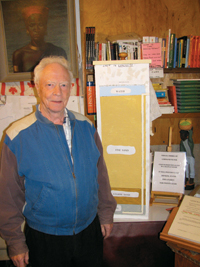
Canada’s ground water drillers are not the only ones helping to provide
Haitians with clean drinking water. Bernie Crawshaw, a retired
teacher-librarian in Delhi, Ont., has done his best to support two
colleges in Haiti with educational supplies and equipment, plus bio-sand
water filters for the schools and households.
Canada’s ground water drillers are not the only ones helping to provide Haitians with clean drinking water. Bernie Crawshaw, a retired teacher-librarian in Delhi, Ont., has done his best to support two colleges in Haiti with educational supplies and equipment, plus bio-sand water filters for the schools and households.
 |
|
| Fernlea Ivix Books uses the proceeds from its used book sales to support two colleges in Haiti. Proprietor Bernie Crawshaw also welcomes donations for clean water bio-sand filters like the full-size model shown. Advertisement
|
Shortly after his retirement in 1987, Crawshaw founded Fernlea Ivix Books, a non-profit used book store that is open seven days a week from 2 to 5 p.m., and managed and staffed by dedicated volunteers.
From humble early beginnings, the shop has greatly expanded and now shelves some 23,500 volumes. Hardcover books range in price from $6 to $125. The vast majority of sales, though, come from paperbacks that sell for 25 cents to $4.
While the proceeds from these sales are used mainly for buying educational supplies, Crawshaw also commissioned a Canadian ground water driller last year to establish a fresh water well in the vicinity of the two colleges.
“One report was that they (the locals) tried to dig the well by hand, which would never work.” Crawshaw explained that even if fresh water were found with an open well it would always be contaminated unless the brick or stone walls were properly sealed and no run-off water allowed to enter the supply.
“Another report was that the schools were too close to the ocean so the water would be brackish,” he was advised. “Regardless of what happened, no water was found so he gave me my money back,” Crawshaw said of the well driller. “They (the colleges) pretty much rely on cisterns to catch the rain water but it would be really nice if someone tried drilling there again.”
Until that happens, Crawshaw said the need for clean water is unending. A bio-sand water filter can be bought for only $50, and such a donation made at Fernlea Ivix Books, will ensure a Haitian home gets one. Contributors will also receive a certificate from the store acknowledging their gift.
“One of the nicest things about the filter is that it can be made and maintained using the local building materials Haiti already has,” he said, while showing the full-scale model of the filter displayed in the shop. Literature explaining how the filter works is also on hand.
According to the Centre for Affordable Water and Sanitation Technology (CAWST), the bio-sand water filter is a fairly recent invention, but has undergone extensive testing at the University of Calgary. The system has proven so effective that the filter has become one of the most widely distributed devices for household water treatment in developing countries.
Since its introduction to Haiti in 1999, its use has spread throughout the country. There are currently more than 8,000 filters distributed throughout Haiti by various organizations, such as Lifewater (see story on page 32) and Fernlea Ivix Books.
The bio-sand filter is simple in design: there are no moving parts, and it requires no electricity and only one square foot of space to sit on. With proper use, a filter will last for an indefinite period of time.
The filter is able to solve the problem of treating multiple water sources because it removes all four types of pathogens – bacteria, protozoa, viruses and worms. Two weeks after installation, a bio-sand filter will remove 98.9 per cent of all bacteria present in the water.
How does it work?
Water is poured into the top of the filter as needed, where a diffuser plate placed above the sand bed dissipates the initial force of the water. Travelling slowly through the sand bed, the water then passes through several layers of gravel and collects in a pipe at the base of the filter. Gravity moves the water upward through the plastic piping encased in the concrete exterior, and out of the filter for the user to collect.
As with all slow bio-sand filters, the removal of pathogens occurs in the filter thanks to a combination of biological and mechanical processes. When water is poured into the top of the filter, the organic material it is carrying is trapped at the surface of the fine sand, forming a biological layer of “schmutzdecke,” which translates to “dirt cover.”
Over a period of one to three weeks, micro-organisms colonize the schmutzdecke, where organic food and oxygen derived from the water abounds. In this gelatinous biofilm layer beneficial bacteria and fungi devour water-borne pathogens effectively making the water potable.
For more information on Fernlea Ivix Books, contact berniecrawshaw@gmail.com.
Print this page